Beef Products
Whole Primal Cuts | Oven Roasts | Pot Roasts | Steaks | Ribs | Variety Meats
Miscellaneous Cuts | Canned | Dried | Salted | Miscellaneous Products
Individual Beef Cuts and Miscellaneous Beef Products
Select one of the beef product groups above to learn about the
individual beef cuts and the miscellaneous beef products available in that group.
|
Whole Primal Cuts
Whole primal beef cuts may be purchased from a butcher or meat locker or it may be possible to obtained them from a special order from some food stores. Because of their size, it is generally not practical to order whole primal beef cuts for home use. They will be more economical, but if you are not knowledgeable on how to cut the primal into smaller cuts of beef, the result will be too much waste, incorrect cuts, and elimination of any potential costs savings. |
|
Oven Roasts
An oven roast is usually a minimum of 2 inches thick. The dry heat of oven roasting enhances the flavor and tenderness of the beef if it is not overcooked. The best oven roasts are from the tender cuts of the loin and rib primals. Round cuts, which are usually best when pot-roasted, may be purchased as oven roasts if the cuts are of the highest quality. |
|
Rib-Eye Roast
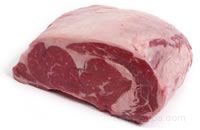
|
The rib-eye roast refers to a rib roast that has had the 6th through the 12th rib bones removed leaving just the rib-eye muscle. It is tender, flavorful, and expensive. The rib-eye roast is also known as a Delmonico roast. |
|
Rib Roast
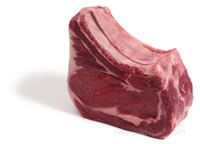
|
A rib roast that includes the bones is also known as a standing rib roast. Because of its size, a full rib roast (ribs 6 through 12) is often cut and sold as two separate roasts known as the first cut rib roast and the second cut rib roast. The first cut is also called a small end rib roast and includes ribs 9 or 10 through 12, which is next to the loin primal. The second cut, also known as the large end rib roast, includes ribs 6 through 8 or 9 and is next to the chuck primal. Although it is very tender, its proximity to the chuck means that it is slightly less tender than a first cut rib roast.
The beef roast known as "Prime Rib" usually refers to a rib roast, but it doesn't necessarily refer to a rib roast that is graded "Prime". Prime grade rib roast may be available to some restaurants, but is rarely available to the generally public unless it is specially ordered. Most rib roasts sold in food stores are graded "Choice". |
|
Rolled Rib Roast
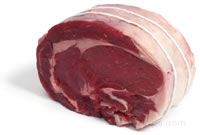
|
A rib roast that is boned, rolled, and tied is known as a rolled rib roast. |
|
Top Loin Roast
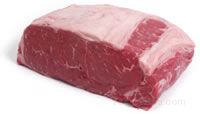
|
The top loin is the largest muscle of the short loin. The top loin roast is cut from the top loin and it is also known by the following names:
- New York Strip Roast
- Shell Roast
- Strip Loin Roast
|
|
Tenderloin Roast

|
The tenderloin is the inside muscle of the short loin. It is the most expensive cut of beef and can be roasted whole or it can be cut into tender, boneless steaks. The tenderloin roast is also known as:
- Whole Filet
- Filet Mignon Roast
- Tenderloin Tip Roast
|
|
Top Sirloin Butt Roast

|
The top butt is one of the two main muscles of the sirloin. The top butt is a bit better in quality than the bottom butt and is very suitable for oven roasting if it is not overcooked. |
|
Tri-Tip Roast
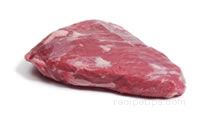
|
The tri-tip is a triangular shaped cut at the tip of the sirloin and is surrounded by the remainder of the sirloin and the round and flank primals. It can be used as an oven roast or it can be cut into steaks. The tri-tip is excellent when barbecued or grilled, but it can easily become very tough if cooked improperly. The fat should not be trimmed until after cooking because it helps to seal in the juices, keeping the meat tender. The tri-tip roast is also known as the triangle roast. |
|
Pot Roasts
Cuts from the chuck are among the most popular cuts for pot-roasting (braising). They have plenty of connective tissues that melt when the meat is pot-roasted making it tender and flavorful. Beef cuts from the round and brisket are also used. Cuts used for pot roast benefit from the moist heat of pot-roasting, which helps to tenderize the meat. |
|
Boneless Chuck Eye Roast
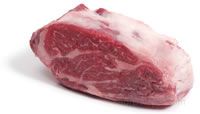
|
The chuck eye is a continuation of the rib-eye meat. It is similar to the rib-eye meat of the rib primal (ribs 6-12) except that it is located in the chuck primal (ribs 1-5). The chuck eye is also not as tender as the rib-eye meat, but it is still one of the most tender of the chuck roasts. The chuck eye roast is usually braised, but it can also be oven roasted if it is not overcooked. Alternate names for the chuck eye roast include:
- Boneless Chuck Fillet
- Boneless Chuck Roll
- Chuck Tender
- Scotch Tender
|
|
Top Blade Roast

|
The top blade is located above the shoulder blade and is known as the top blade roast. Although it is usually braised, it is tender enough to be oven roasted if it is not overcooked. Other names for the top blade roast include:
- Flatiron Roast
- Top Chuck Roast
- Blade Roast
- Chuck Roast First Cut
- Lifter Roast
- Triangle Roast
|
|
Mock Tender Roast

|
The mock tender is often sold as a roast and is a cone shaped muscle next to the top blade in the chuck primal. The name "mock tender" is misleading because the meat isn't very tender and is best when it is braised. Alternate names for the mock tender roast include:
- Medallion Pot Roast
- Fish Muscle
- Fillet Roast
|
|
Under Blade Roast
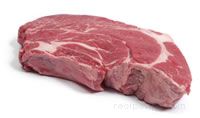
|
The under blade is directly below the shoulder blade and is sold as the under blade roast or under blade steaks. It is also known by the following names:
- Bottom Chuck Roast
- California Roast
|
|
7-Bone Roast
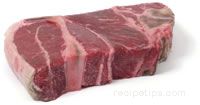
|
The 7-bone roast is a cross cut roast of the shoulder blade. It gets its name from the cross cut of bone that is shaped like a "7". The 7-bone roast is one of the most popular for pot-roasting. It is also known by the following names:
- Center Cut Pot Roast
- Chuck Roast Center Cut
|
|
Arm Roast

|
The arm roast is one of the most popular pot roasts. It can be reduced to a smaller cut known as an arm steak, which is also known as Swiss steak. The arm roast is also called:
- Arm Pot Roast
- Arm Chuck Roast
- Round Bone Pot Roast
|
|
Boneless Shoulder Roast
The boneless shoulder roast is also know as the English roast and is located right behind the arm roast. |
|
Cross-rib Roast
A cross-rib roast contains the meaty portions on the top of ribs 3 through 5. The best results occur when it is pot-roasted. The cross-rib roast is also known by the following names:
- Boston Cut
- English Cut
- Bread and Butter Cut
- Shoulder Clod
|
|
Neck Pot Roast
The meat is obtained from the 7 neck vertebrae. Stew meat is also cut from this area. |
|
Bottom Round Roast
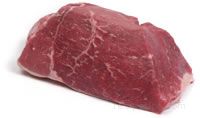
|
The bottom round is the outside muscle of the upper leg. The bottom round roast can be used as an oven roast if it is of the best quality, but it can become very tough and chewy if it is roasted too long. Excellent results can be achieved if it is roasted in a hot oven (450ºF), which will sear the exterior, sealing in the juices and preventing the meat from becoming too tough. The best results occur when the meat is pot-roasted, which helps to tenderize it the meat. |
|
Boneless Rump Roast
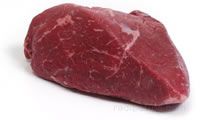
|
A boneless rump roast is sometimes sold as is or it may be rolled and tied before it is packaged and sold. |
|
Standing Rump Roast
A standing rump roast is a rump roast that has not had the bone removed. It can be very flavorful and tender when pot-roasted. |
|
Eye Round Roast
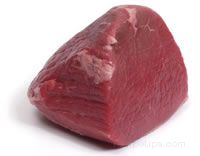
|
The eye round is the eye muscle of the bottom round. The eye round roast is boneless and can be a bit tough, so it is best to cook it with a moist heat process such as pot-roasting. |
|
Top Round Roast
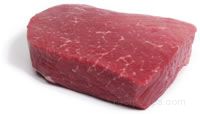
|
The top round roast is obtained from the top round muscle. It is one of the better cuts from the round primal in terms of flavor. Pot-roasting is still the recommended cooking method for a top round roast, because it can be a bit chewy if cooked with dry heat methods. |
|
Round Tip Roast
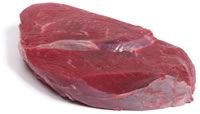
|
The round tip is next to the sirloin tri-tip so it is a bit more tender than other round roasts. It may be oven roasted if it is of top quality and it is often cut into pieces for use as kabob meat. |
|
Brisket

|
The brisket is located between the fore shank and the plate. It is usually sold boneless and it is flavorful, but tough. Pot-roasting helps to make the meat more tender. |
|
Steaks Steaks are among the most popular fresh beef cuts. The best steaks, in terms of tenderness, are from the loin and include the Filet mignon, Porterhouse, T-bone, and top loin strip. Steaks cut from the chuck, round, and flank are much less expensive and less tender, but they are very flavorful. |
|
Chuck Eye Steak

|
The chuck eye steak is a smaller cut from the chuck eye roast. It is best when braised, but it can be grilled or broiled if it is not overcooked. The chuck eye steak is also known as:
- Boneless Chuck Slices
- Boneless Chuck Fillet Steak
|
|
Top Blade Steak
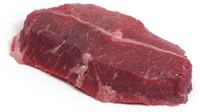
|
The top blade steak is a smaller cut from the top blade roast and is also known as the "Flatiron Steak". It is called the flatiron steak because when the top blade roast is cut horizontally into two pieces, the resulting shapes resemble an old fashioned flatiron. Other names for the flatiron or top blade steak include:
- Top Boneless Chuck Steak
- Petite Steak
- Lifter Steak
- Book Steak
- Butler Steak
The top blade, or flatiron steak, is quite tender, flavorful, and well marbled, and it is much less expensive than similar cuts. It is an excellent candidate for grilling or broiling and does not require marinating or any other mechanical tenderizing. It should not be cooked beyond medium or it will quickly toughen. |
|
Mock Tender Steak
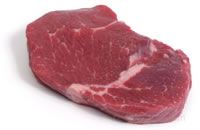
|
The mock tender is often sold as a roast and is a cone shaped cut next to the top blade in the chuck primal. It can also be cut into steaks. The name "mock tender" is misleading because the meat is rather tough and it is best when it is braised. It is also known as:
- Fish Steak
- Chuck Fillet Steak
- Chuck Tender Steak
|
|
Under Blade Steak
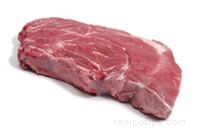
|
The under blade is directly below the shoulder blade and can be cut into steaks. It is not suitable for grilling or broiling, but is quite good when it is braised. |
|
Arm Steak (Swiss Steak)
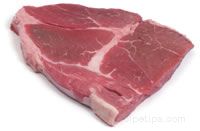
|
A steak cut from the arm roast is often referred to as a Swiss steak (as is a steak from the bottom round). Braising is the best cooking method for this tougher cut. |
|
7-Bone Steak
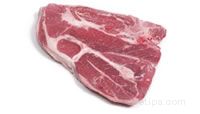
|
The 7-bone steak is a cross cut steak of the shoulder blade. It gets its name from the cross cut of bone that is shaped like a "7". It is a bit tough, so it is best to braise it. |
|
Rib-Eye Steak
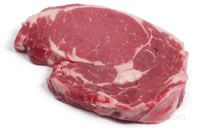
|
The rib-eye steak is cut from the rib-eye roast. It is flavorful, tender, and fairly expensive. It is best when grilled or broiled. Other names for the rib-eye steak include:
- Delmonico Steak
- Beauty Steak
- Market Steak
- Spencer Steak
|
|
Rib Steak

|
A rib steak is cut from the rib roast. It is the same steak as the rib-eye, except that it contains the bone. It is best when grilled or broiled. |
|
Tenderloin Steak
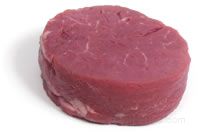
|
The cuts from the tenderloin are the most desirable beef cuts in terms of tenderness. The trimmed tenderloin makes an excellent roast or it can be cut into steaks. Grilling, broiling, and sautéing are the best methods for cooking tenderloin steaks.
Various names for tenderloin steaks include:
- Filet Mignon
- Tournedos
- Filet Steak
- Châteaubriand
- Bifteck
|
|
Boneless Top Loin Steak
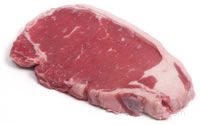
|
Boneless top loin steaks are tender and flavorful and are best prepared using grilling, broiling, sautéing, or pan-frying cooking methods. The boneless top loin steak is known by different names depending on the area of the country it is purchased.
Various names for boneless top loin steak include:
- Strip Loin Steak
- New York Strip Steak
- Kansas City Steak
- Ambassador Steak
- Boneless Club Steak
- Hotel Style Steak
- Veiny Steak
|
|
Bone-in Top Loin Steak
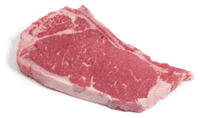
|
Bone-in top loin steaks are tender and flavorful and are much like a Porterhouse or T-bone, but with the tenderloin portion removed. The best methods for cooking bone-in top loin steaks are grilling, broiling, sautéing, and pan-frying. The bone-in top loin steak is known by different names depending on the area of the country it is purchased.
Various names for bone-in top loin steak include:
- Club Steak
- Chip Club Steak
- Country Club Steak
- Delmonico Steak (Also refers to a rib-eye steak)
- Shell Steak
- Strip Loin Steak
|
|
Porterhouse Steak
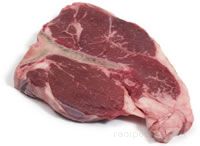
|
The Porterhouse steak is a crosscut steak containing part of the tenderloin and part of the top loin, which are separated from each other with a "T" shaped bone. It is similar to a T-bone steak except that it is thicker and the proportion of the tenderloin to the top loin is greater. The flavor and tenderness or the steak is enhanced with grilling, broiling, sautéing, and pan-frying. |
|
T-bone Steak
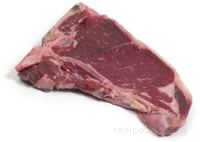
|
Like the Porterhouse, the T-bone steak is a crosscut steak containing part of the tenderloin and part of the top loin. The main difference between it and the Porterhouse is that the T-bone contains less of the tenderloin. A T-bone steak is best when is is grilled, broiled, sautéed, or pan-fried. |
|
Top Boneless Sirloin Steak
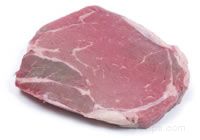
|
The boneless sirloin is a flavorful and somewhat tender steak obtained from the top butt muscle of the sirloin. It can be grilled, broiled, sautéed, or pan-fried and is even better if it is marinated first. |
|
Tri-Tip Steak

|
The tri-tip is a triangular shaped cut at the tip of the sirloin and is surrounded by the sirloin, round, and flank primals. It can be used as a roast or it can be cut into steaks. The tri-tip steak is excellent when it is grilled or broiled, but it can easily become very tough if it is overcooked. The fat should not be trimmed until after cooking because it helps to seal in the juices, keeping the meat somewhat tender. The tri-tip is also known as:
- Triangle Steak
- Culotte Steak
|
|
Sirloin Bone-in Steaks

|
- Pin Bone: A pin bone steak is a cross cut from the from the front section of the hip and is next to the Porterhouse. It is tender and flavorful and it can be grilled, broiled, sautéed, or pan-fried. The results are even better if it is marinated first.
- Flat Bone: A flat bone steak is another cross cut from the from the front section of the hip. Like the pin bone, it can be grilled, broiled, sautéed, or pan-fried and benefits from being marinated first.
- Round Bone: The round bone is a third cross cut steak from the front section of the hip and like the others, it can be grilled, broiled, sautéed, or pan-fried and benefits from being marinated first.
- Wedge Bone: The fourth cross cut from the front section of the hip, known as the wedge bone steak, is the least tender of the four because of its proximity to the rump. It should be marinated, which allows it to be grilled, broiled, sautéed, or pan-fried.
|
|
Eye Round Steak
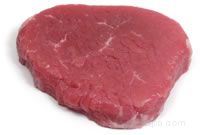
|
The boneless eye round steak is a small cut obtained from the eye round roast. It is lean and tough and should be braised for the best results. |
|
Top Round Steak
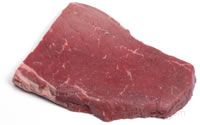
|
The top round steak is a thick steak that is cut from the top round roast. A thinner steak cut from the top round roast is simply called a round steak. The top round is flavorful and a bit more tender than other round cuts, but it should still be marinated first if it is to be grilled or broiled. It is sometimes referred to as a London Broil, which also is a name given to a flank steak. |
|
Bottom Round Steak
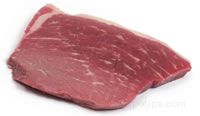
|
The bottom round steak is often referred to as a Swiss steak (as is a chuck arm steak). Braising is the best cooking method for this tougher cut. |
|
Round Steak
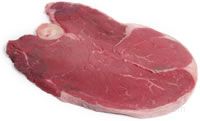
|
A round steak often refers to a thin steak that is cut from the top round roast. A thicker steak cut from the top round roast is known as a top round steak. Round steak is a bit tough, so it is best to braise it.
A round steak may also refer to a cross cut steak from the round that includes parts of the eye, top, and bottom round. |
|
Round Tip Steak

|
The round tip steak is cut from the untrimmed round tip roast. If the steak is obtained from the trimmed roast, it is known as a trimmed tip steak or a ball tip steak. It can be quite good when it is grilled or broiled, especially if it is marinated first. |
|
Flank Steak
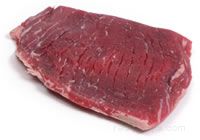
|
A flank steak is very lean and full of flavor. It is delicious when grilled, but it will become very tough if cooked too long. It is best to marinate it before cooking. The flank steak is also known by the following names:
- London Broil: the name often given to a flank steak, but a London Broil can also be cut from the top round.
- Jiffy Steak
- Flank Steak Fillet
|
|
Skirt Steak
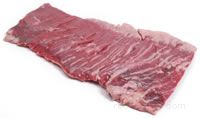
|
A skirt steak has much more marbling than a flank steak and as a result, it is more juicy and very flavorful. It can be prepared with almost any type of cooking method, but it should be marinated first if using a dry heat cooking method such as grilling or broiling. The skirt steak is also known by the following names:
- Outside Skirt Steak
- Inside Skirt Steak
- Philadelphia Steak
|
|
Hanger Steak
The hanger steak, or hanging tenderloin, is the thick strip of meat that is located on the underside of the carcass and hangs between the last rib and the loin. It is actually part of the diaphragm. Like the skirt steak, it is very flavorful and it can be prepared with almost any type of cooking method, but it should be marinated first if using a dry heat cooking method such as grilling or broiling. The hanger steak is also known by the following names:
- Hanging Tenderloin
- Hanging Tender
- Butcher's Steak
|
|
Ribs
The beef carcass has 13 pairs of ribs, but not all of the ribs are included in the rib primal cut. The first 5 ribs are part of the chuck cut in the front of the animal. The 13th rib is part of the loin. The rib primal contains ribs 6 through 12.
A short rib refers to a small piece that has been trimmed from the main portion of a rib when the rib cage is trimmed into smaller cuts. Short ribs are cut from the chuck and plate primals and back ribs are from the rib primal. Short ribs cut parallel to the bone are known as English style short ribs. They may include a bit of the bone or may be sold boneless. Short ribs that are cut across the rib bones are known as flanken. |
|
Short Ribs (Chuck)
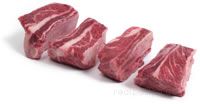
|
Ribs 1 through 5 are located in the chuck primal. They have plenty of meat and have less fat than short ribs from the plate. |
|
Short Ribs (Plate)
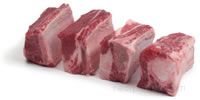
|
The ends of the 6th through the 12th ribs are contained within the plate primal cut. The plate short ribs are usually taken from the flat ends of ribs 6 through 9 and are cut only a few inches long. The ends of ribs 10 through 12 have more fat than meat. |
|
Back Ribs
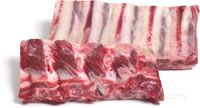
|
Back ribs are the portion remaining after a rib roast is boned. The full back ribs are long and do not have a lot of meat, but they are tender and tasty when grilled. |
|
Variety Meats Variety meats include some of the organs and extremities. Some variety meats are readily available in food stores and most are available from a butcher or specialty meat market, but may require special ordering. They are very perishable, so if they are not going to be used within 24 hours of purchasing, they should be frozen immediately. |
|
Liver

|
Beef liver has a rich, intense flavor, but is high in cholesterol. |
|
Heart

|
The heart has a rich flavor and is best prepared with braising or stewing because of the toughness of the meat. |
|
Kidneys
Beef kidneys are tough and have a slightly bitter flavor. They are also as high in cholesterol as liver. |
|
Tripe
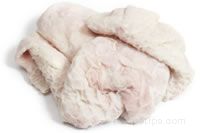
|
Tripe is the edible lining of the stomach that can be fried or sautéed, but braising makes it very tender. |
|
Tongue

|
Tongue is often poached or braised and can be ground or sliced and served in sandwiches. It is available fresh, cured, or smoked. |
|
Oxtail

|
The oxtail has an intense flavor and is often used to enhance soups and stews. |
|
Miscellaneous Cuts Some fresh beef cuts or scraps are ground, rolled, tenderized, cubed, or sliced in food stores or meat markets into various products that add convenience for the consumer. |
|
Ground Beef, Bulk Packages
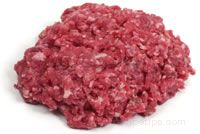
|
The label on a package of ground beef may say ground chuck, ground sirloin, or ground round based on the part of the animal from which the meat has been obtained. A package that just says ground beef, indicates that the meat may have been taken from several areas of the carcass. (In order to be labeled ground beef, the product must be at least 70% lean.) |
|
Ground Beef, Patties
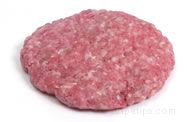
|
Ground beef is also formed into patties and packaged in various quantities. The patties are usually sold frozen. |
|
Rolled Steak
Large steaks are sometimes rolled and tied and used as an oven roast. Occasionally, stuffing is placed on the steak before it is rolled. After roasting, the steak is untied and sliced. Rolled steaks are available in most food stores already rolled, stuffed, and tied. |
|
Minute Steak

|
A minute steak is boneless, very thin, and is usually scored and pounded to tenderize it. Various cuts can be used for a minute steak, but most often it is a thinly sliced piece of boneless sirloin or eye of round. Because of its small size, it usually requires only a minute per side to cook, using high heat. |
|
Stew Meat
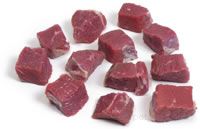
|
Fresh stew meat is usually taken from the tougher cuts because the stewing process tenderizes the meat. The best stew meat is from the chuck because it is very flavorful. |
|
Kabob Meat

|
Beef for kabobs can be purchased that has already been cut into the appropriate sized chunks, which are ready to assemble onto skewers. |
|
Kabobs
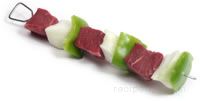
|
Complete beef kabobs can also be purchased, which consist of alternating pieces of marinated beef and vegetables that have been inserted onto skewers and are packaged in various quantities. |
|
Beef Strips
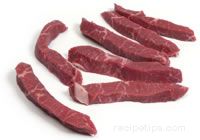
|
Beef can be purchased that has been cut into strips for convenient use in stir-fry recipes. |
|
Canned Beef Products Commercially prepared canned products containing beef are widely available. The products are fully cooked, so additional cooking is not required although heating the products for a short period improves the flavor. Canning allows the products to remain wholesome for extended periods. |
|
Beef Stew
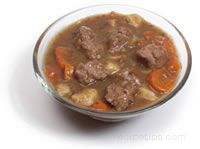
|
Various brands and types of beef stew are available with ingredients and seasonings that make each one a bit different. |
|
Roast Beef Hash
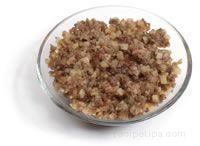
|
Like beef stew, many different recipes of roast beef hash are available as a canned product. |
|
Chili
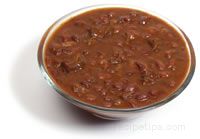
|
Chili is one of the most popular canned beef products and is available with beef chunks or ground beef prepared with a wide variety of ingredients. |
|
Beef Broth
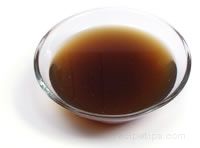
|
Canned beef broth is available in most food stores. It is usually strained and most of the fat has been removed so that it makes a good base for a variety of soups, stews, casseroles, and braised dishes. |
|
Beef Soup, Thin
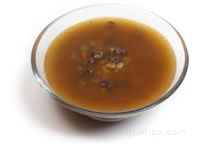
|
Beef soup is usually prepared with small pieces of beef, vegetables, and various seasonings. Some beef soups have a thin consistency while others are very thick, almost like a stew or a casserole, and some may also contain noodles. |
|
Beef Soup, Thick

|
|
Italian Main Dishes
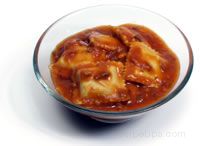
Ravioli
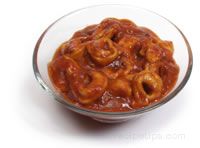
Tortellini |
Italian dishes such as spaghetti and meatballs, beef ravioli, tortellini, and lasagna, which are available canned, are prepared with a variety of recipes depending on the manufacturer. |
|
Beef Gravy
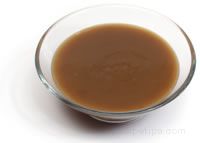
|
Commercially prepared beef gravy is available canned and is ready to heat and serve. |
|
Dried Beef Products Various cuts of beef can be preserved using a combination of seasonings and drying processes, performed under controlled conditions, to produce food items that have a long shelf life. |
|
Beef Jerky
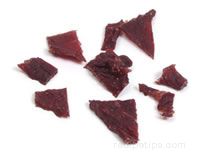
|
Beef jerky is a dried beef product in which strips of beef are seasoned and dried. The strips were traditionally dried in the sun, but today are dried in large commercial dryers or dehydrators. The texture is tough and chewy, but the jerky strips are very flavorful and keep for long periods. |
|
Biltong
Biltong is a dried beef product that is much like beef jerky, but it is seasoned differently and is South African in origin. |
|
Bresaola

|
Bresaola is an Italian air-dried beef product that is sliced very thin and is usually served with olive oil blended with finely chopped parsley and a bit of lemon juice. |
|
Chipped Beef
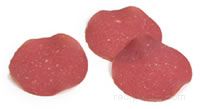
|
Chipped beef is an air-dried product that is similar to bresaola, but not as tasty. It is often added to sauce or gravy and served on toast. |
|
Bouillon

|
Bouillon powder or cubes can be used as a flavoring for soups and stews. |
|
Soup Mix

|
Commercially produced dried mixtures for soup can be purchased that can be prepared with the addition of water. |
|
Gravy Mix
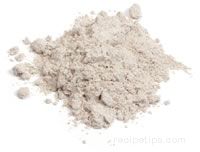
|
Commercially produced dried mixtures for gravy can be purchased that can be prepared with the addition of water. |
|
Salted Beef Products Beef can be preserved with large quantities of salt or through the use of brine solutions. The preservation process lengthens the time that the products can be safely used. |
|
Salt Beef
Salt beef is usually a cut from the round section that is soaked in a brine solution. Some types of salt beef need to be soaked in water before they are used because the brine may be particularly salty. |
|
Pastrami
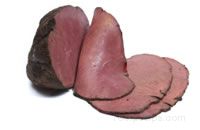
|
Pastrami is a salted beef product that is seasoned with peppercorns and spices and is dry-cured and smoked. It is popular as sliced delicatessen meat. |
|
Corned Beef
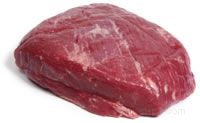
|
Corned beef refers to beef that has been preserved and flavored in a brine solution that is usually prepared with salt, which acts as a preservative. Sugar is stirred into the brine solution, which prevents the meat from getting hard due to the presence of the salt. Also added to the solution is saltpeter, which helps to maintain the red coloring of the meat and various spices are added for flavoring. The reason it is called corned beef is because the old English word "corned" was used to describe beef that was cured and the word "corn" was the word describing a small kernel or particle such as the particles of salt that were used. Corned beef is available as a sliced deli meat for sandwiches or whole corned beef briskets are available that are often served with cooked cabbage. |
|
Miscellaneous Products |
|
Frozen Whole Beef Cuts
Whole fresh beef cuts may be packaged and frozen before they are purchased by the consumer. |
|
Barbecued Beef Ribs
There are several brands of beef ribs that have been fully cooked with barbecue sauce added. They are available ready to heat and eat or they may be purchased frozen to be heated later, either conventionally or in a microwave. |
|
Barbecued Shredded Beef
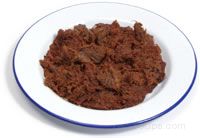
|
Like prepared barbecued ribs, fully cooked, shredded barbecued beef can be found in the refrigerator or freezer case in most food stores. |
|
Prepared Meatloaf
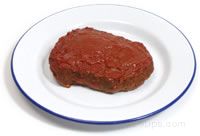
|
Commercially prepared meatloaf is available in most food stores and is ready to heat and eat or it may be purchased frozen to be heated later, either conventionally or in a microwave. |
|
Prepared Meatballs
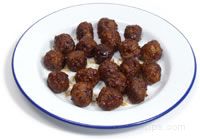
|
Commercially produced meatballs are prepared with a variety of flavorings and are then frozen and sold in most food stores. They are also available ready to eat as a deli item. |
|
Microwave Beef Dinners
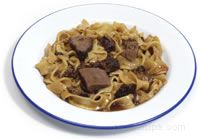
|
Complete dinners, with beef as the main ingredient, are commercially prepared, frozen, and can be microwaved for convenient use. |
|
Beef Pot Pie
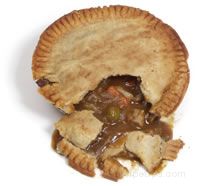
|
Beef pot pies, which are produced by many food companies, are similar to a thick beef stew surrounded by a flaky crust. They are flash frozen by the manufacturer and are available in the freezer case at most food stores. They are conveniently heated in a conventional oven or in the microwave. |
|
Summer Sausage

|
Summer sausage is a slightly dry sausage, which is often produced with a mixture of beef and pork or all beef as is shown in the picture at the left. Various spices are added, most notably coriander. It is a member of the cervelat family of sausages and does not need to be cooked or refrigerated, thus the reason for the name in reference to being stored without the need for refrigeration. This sausage, also known as thuringer, is served as an appetizer, as a snack with bread and cheese, or as a sandwich meat. |
|
Ring Bologna
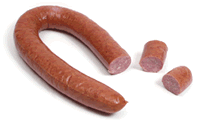
Coarsely Ground
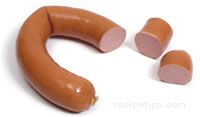
Finely Ground |
Ring bologna, which is usually made from a mixture of beef and pork, is available fresh or fully cooked and coarsely ground or finely ground. |
|
Luncheon Meat

|
Cooked beef is often thinly sliced and sold as luncheon meat in delicatessens or it may be commercially packaged and available in the refrigerator case in most food stores. |
|
Hot Dogs

|
There are several brands of hot dogs that are produced from beef rather than from a mixture of meats such as beef and pork or pork and turkey. |
|
Suet
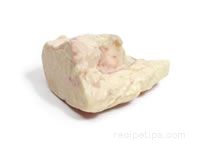
|
Suet is a white, solid fat obtained from the area around the kidneys of beef (and also sheep). It was very popular at one time, but because of increased awareness of health problems associated with saturated fat, it is rarely used today. It is used for the creation of dumplings and for several traditional English steamed puddings, such as steak and kidney pudding. It is also used in the manufacture of tallow candles. Suet is sold in large chunks or in a shredded form in small packets. | |

